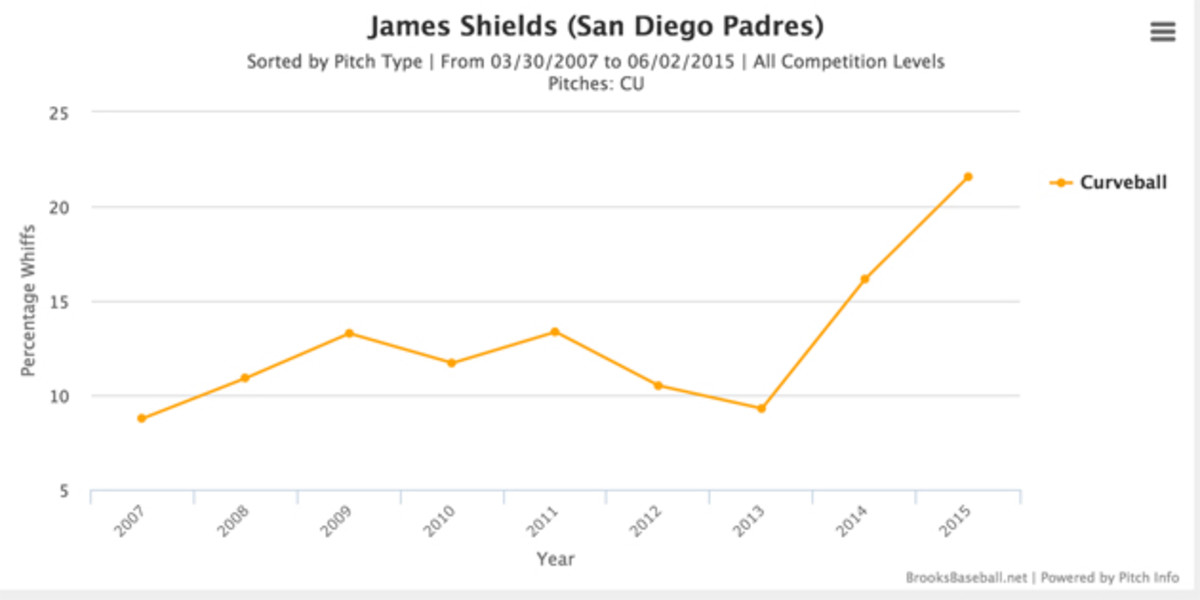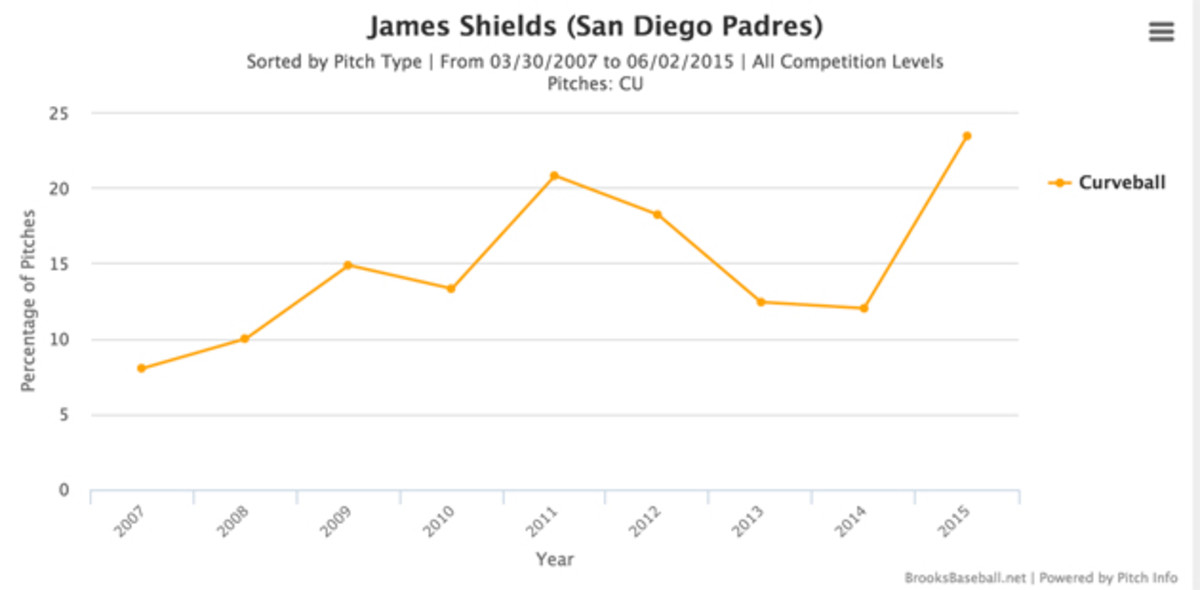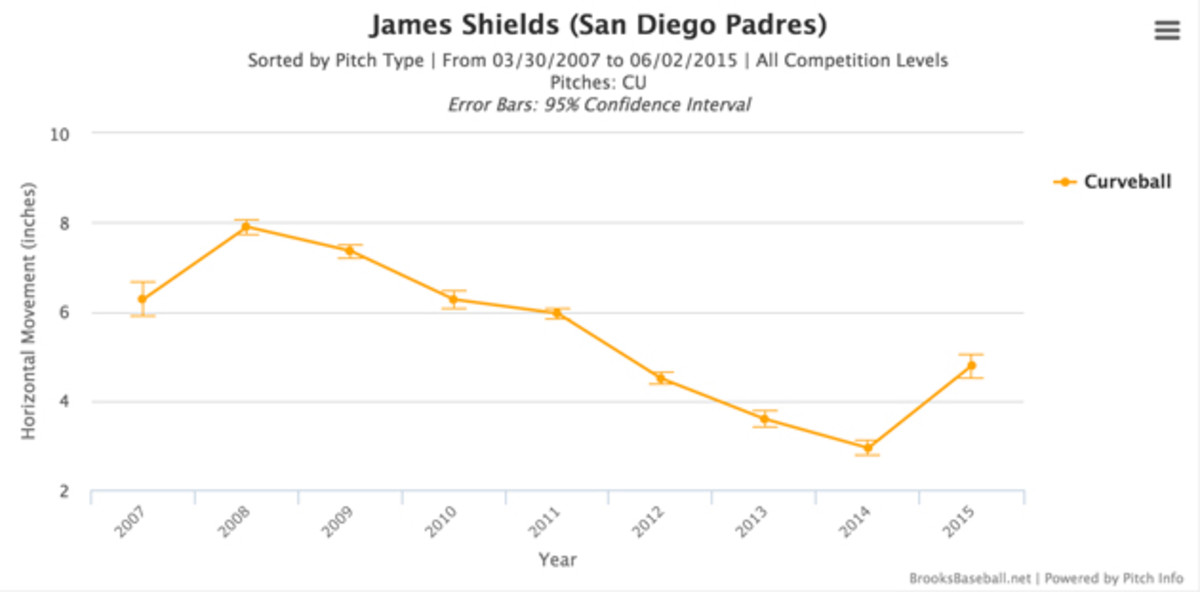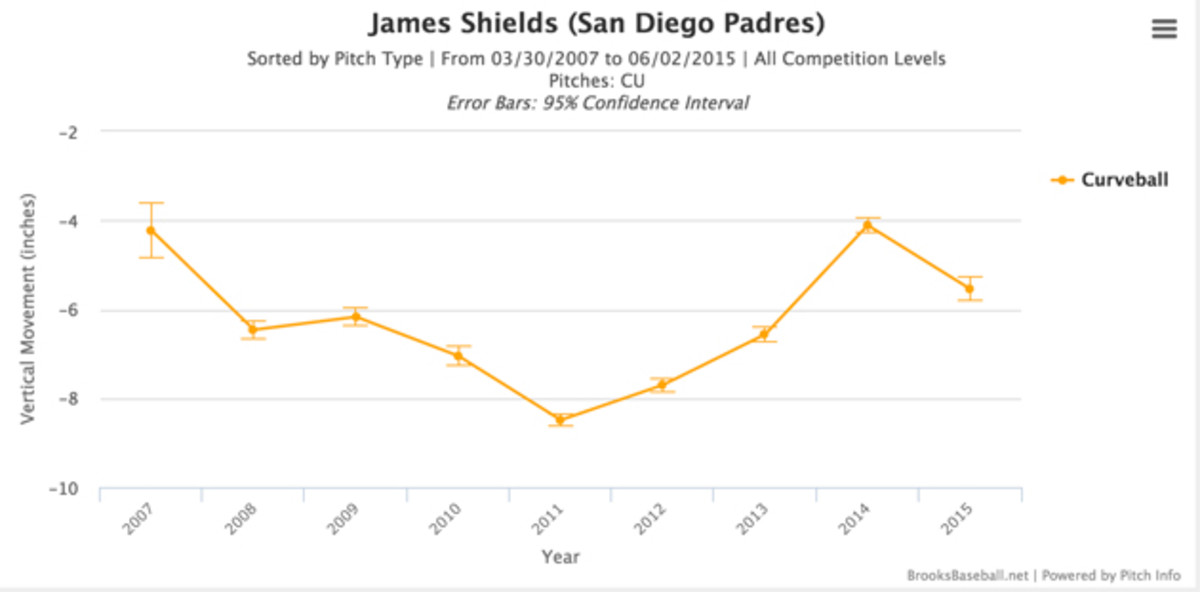Pitcher Scouting: What's behind Shields's increasing strikeout rate?

Bronson Arroyo did it in the past. So did Ted Lilly and A.J. Burnett and Ian Kennedy. The list of pitchers who have transitioned to the National League from the American and seen their numbers improve, potentially without any real change in underlying performance, is long and storied. That’s why the fantasy community took notice when James Shields signed with the Padres late in the off-season. Had Shields remained in the AL, his average draft position among starting pitchers likely would have sat around 30. Instead, he rose all the way to the 21st pitcher off the board in a typical draft, ahead of Gerrit Cole and Sonny Gray.
Hitting report: The most consistent batters through first two months
While Shields hasn’t quite measured up to Cole or Gray, he has been quite good during his first year in the senior circuit. Through 11 starts and 68 1/3 innings, Shields is 6–0 with a 3.69 ERA, 1.21 WHIP and 88 strikeouts. His FIP is 4.38, but the xFIP is down at 2.91, a sign that the measure doesn’t believe the 15 homers he has allowed this year have been completely his fault. It’s the strikeout total, however, that is most interesting here, especially since it’s a large part of the reason he’s the No. 23-ranked starter in standard 5x5 fantasy leagues. How much of that is a function of his joining the NL, and how much owes to his actual performance? Let’s explore.
First, understand that Shields has never been this prolific with the whiff in the first nine years of his career. Before this season, the highest strikeout rate and whiff rate he ever had were 23.6% and 11%, respectively. This season, those rates are up at 30.7% and 14.6%. Now, there’s one obvious factor at play, and that’s the NL’s lack of a DH. However, even if you eliminate all of Shields’ strikeouts of fellow pitchers, his strikeout rate still easily outpaces anything he reached before this season. Ten of Shields’ 88 whiffs came against pitchers. Take those plate appearances out of the equation, and his strikeout rate is 28.2%. You could even leave the plate appearances in, assuming he didn’t have one strikeout of a pitcher this year, and his strikeout rate is still a robust 27.2%.
Pitching Report: Burnett rebounding well in second stint with Pittsburgh
Sure, perhaps the presence of a pitcher in the lineup most nights Shields takes the mound has moved him to a Clayton Kershaw strikeout rate from a David Price one, but that doesn’t change the fact that both of those strikeout artists were at levels Shields could only dream of before this year. Something else is working in Shields’ favor. Allow me to introduce you to his new best friend: his curveball.
Shields has always thrown a curveball and typically had a good amount of success with the pitch. Entering 2015, Shields’ career curveball usage rate was 14.3%. The pitch had a 12.2% whiff rate, and hitters compiled a .237 batting average and .361 slugging percentage when Shields threw it. This season, he’s throwing it 23.4% of the time, getting whiffs a ridiculous 21.6% of the time, and hitters have managed just a .222 batting average (despite a .419 BABIP) and .349 slugging percentage. More than anything, the curveball is driving Shields’ strikeout spike.
If you’re more into graphic representations, below are line graphs of Shields’ curveball whiff rate and usage rate by year, courtesy of Brooks Baseball.


Before taking a look at the pitch, we should note that it’s not just the overall usage of the curveball that has changed significantly this season, but the counts in which he throws it. Shields has thrown the curve on the first pitch in one-fifth of all plate appearances this year, an increase of about four percentage points from his career rate. When he’s ahead in the count, he’s throwing it about 36% of the time, including nearly 40% to righties—up from 21% for his career. Finally, Shields goes to the curveball approximately 30% of the time in two-strike counts, while his changeup, which is still a weapon, had a 42% usage rate in two-strike counts; before 2015, he threw the curveball in this situation only 10% of the time. In other words, Shields has favored the curve over the change as his putaway pitch this season.
Re-ranking the top 50 fantasy baseball players in the 2015 season
That is not to dismiss the changeup, which still has a 20.5% usage rate and 24.2% whiff rate. But his increased curveball usage this season is the main difference in his repertoire, which is why it likely has more to do with his dramatic increase in strikeout rate. He has also thrown the curve more than the change in six of his 11 starts, including six of the last eight (with one tie). This isn’t a case of him loading up on curves against one or two righty-heavy teams that struggle with breaking stuff. This is a fundamental change in approach.
Shields is getting more horizontal movement on the curve than he has since 2011, while the vertical movement is way up from last year, but actually down from his final few seasons in Tampa Bay. You can see both in the graphs below.


And now, the pictures. Shields threw 43 curveballs in a outing against the Cubs last month. He went seven innings in the game, allowing two runs and striking out 11. Here are two of those 11 strikeouts, selected for their differences. The first is a swinging strikeout by lefty Miguel Montero in a 1–2 count. The second is a looking strikeout by righty Jorge Soler in a 2–2 count. In both cases, Shields shows a trust in the pitch. By taking them together, we get an idea of his willingness to throw it in any count to any hitter.
The Soler strikeout highlights an important fact about Shields’ curveball this season. If it were simply a chase pitch, he wouldn’t be having nearly as much success with it. Here he buckles Soler’s knees, but if that pitch bounces it doesn’t do him any good to freeze the hitter. Shields, though, has commanded the pitch in the zone in 2015 better than he has at any point of his career. The pitch has resulted in a strike 51% of the time he has thrown it this season. From 2006 through '14, his curveball went for a strike just 30.3% of the time.
What’s behind Shields’ increasing strikeout rate? The complete answer includes a number of ingredients. He’s benefitting from the NL lineups he only saw sparingly while in the AL. His changeup remains a filthy out-pitch that is particularly dangerous against lefties. He still runs his four-seamer and sinker into the 92-93 mph range in his age-33 season. What really sets it all off, though, is the curveball, which is better than ever and now one of the primary weapons in his arsenal.
